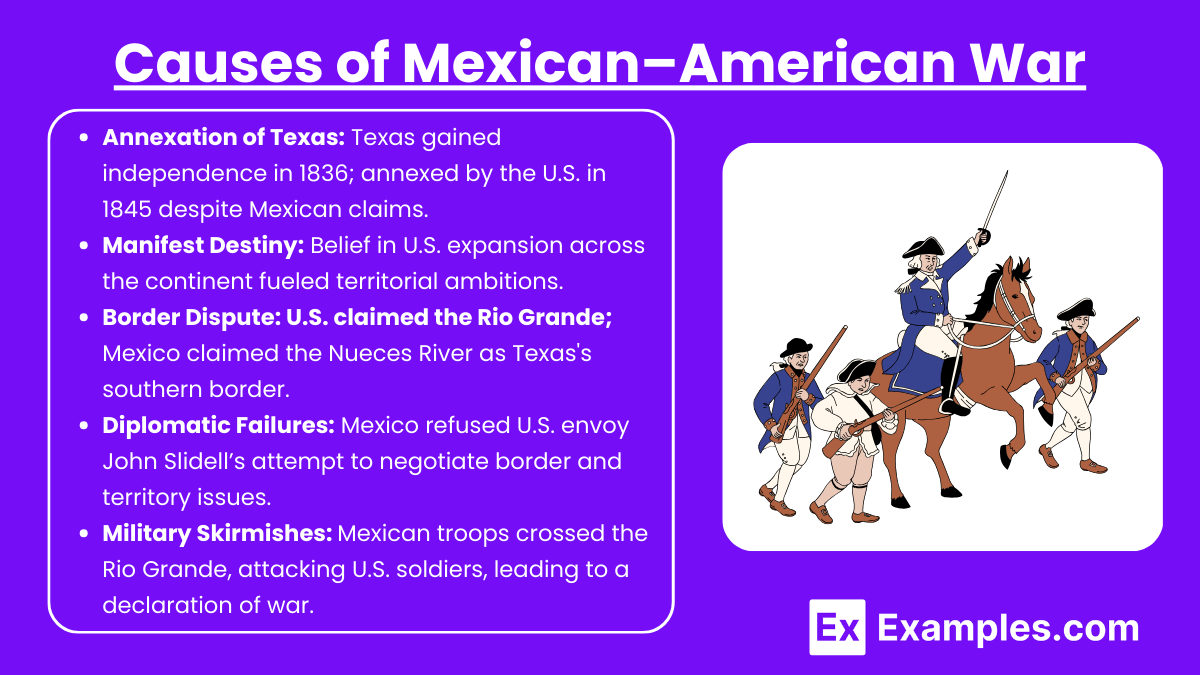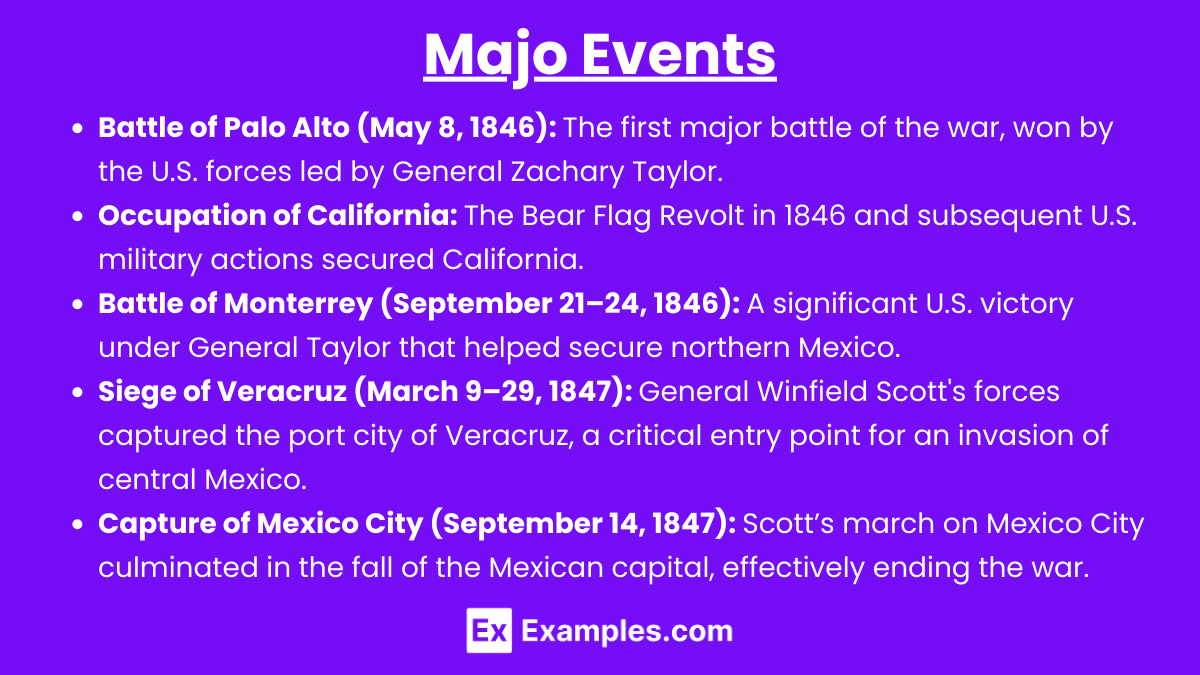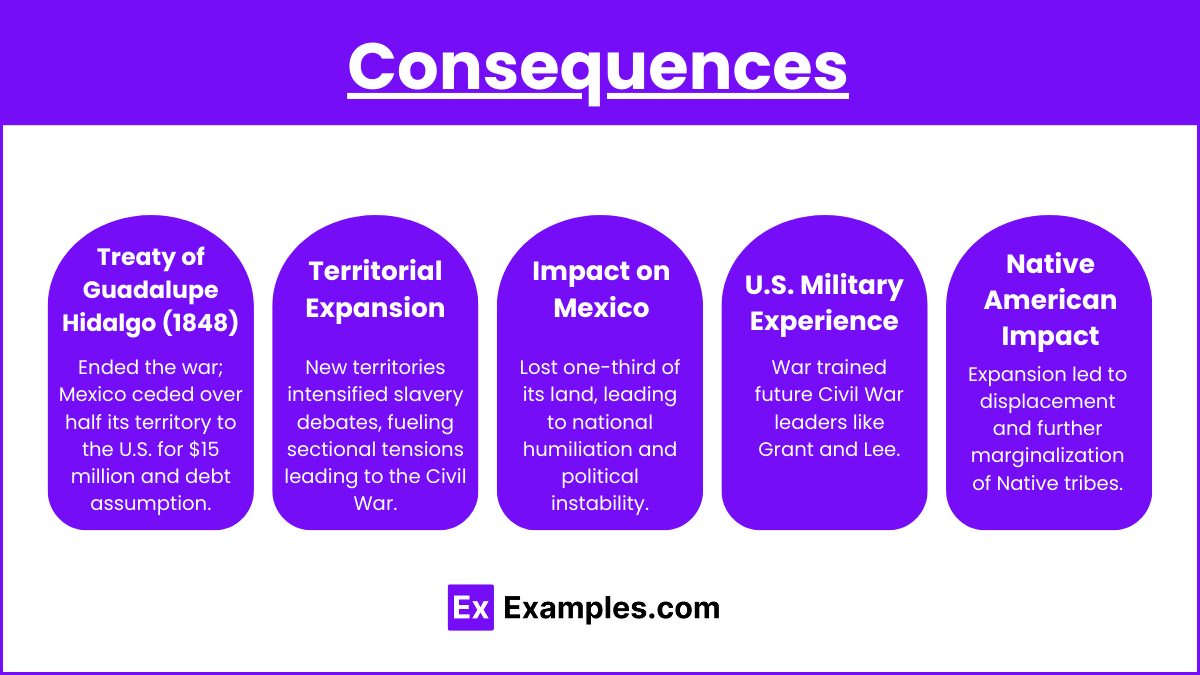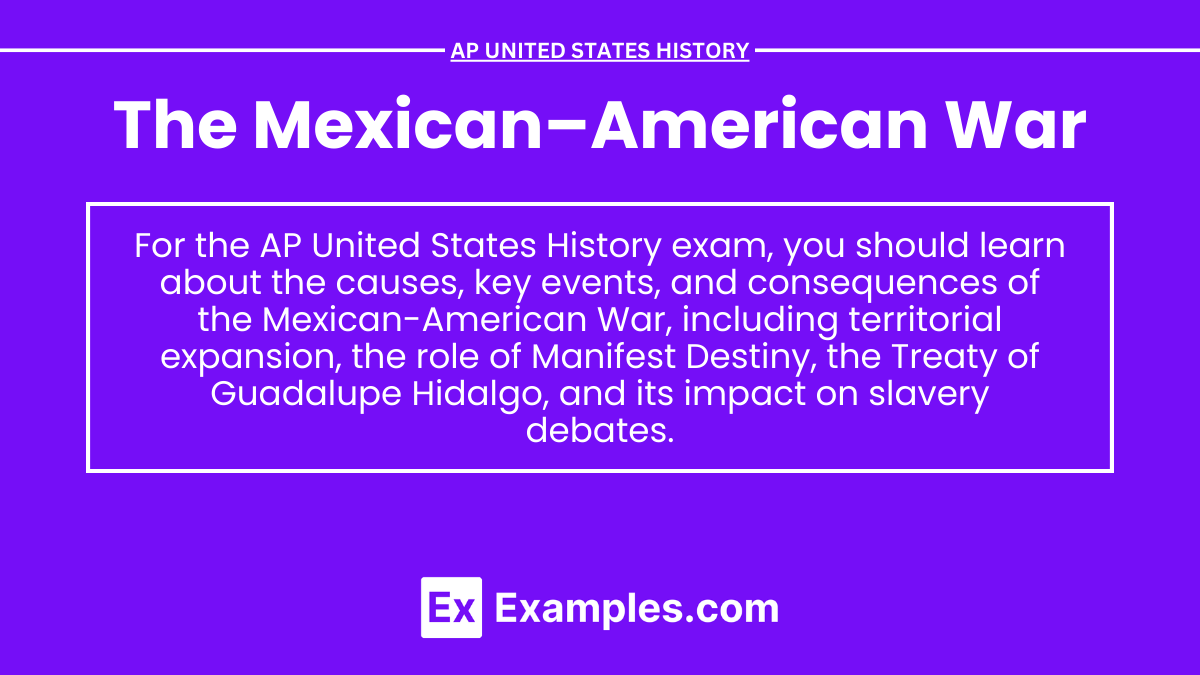In AP United States History, the Mexican-American War (1846-1848) is a pivotal conflict that exemplifies the era of Manifest Destiny, where the United States aggressively expanded its territory across the continent. Sparked by the annexation of Texas and a border dispute between the Rio Grande and Nueces River, the war led to significant territorial gains for the U.S., including present-day California, Nevada, Utah, Arizona, and New Mexico. The war’s outcome, formalized by the Treaty of Guadalupe Hidalgo, not only reshaped the map of North America but also intensified the national debate over slavery, setting the stage for the sectional conflicts that would eventually lead to the Civil War.
Learning Objectives
The learning objectives for the topic “The Mexican-American War” will include the ability to analyze the causes and consequences of the conflict, with a focus on territorial expansion, the role of Manifest Destiny, and the significance of the Treaty of Guadalupe Hidalgo. You will be expected to evaluate the war’s impact on U.S.-Mexico relations, the debate over slavery, and the experiences of various groups affected by the war, including Mexicans, Native Americans, and American settlers.
Causes

Annexation of Texas: Texas gained independence from Mexico in 1836, and in 1845, the U.S. annexed Texas, which Mexico still considered its territory.
Manifest Destiny: The belief that the United States was destined to expand across the North American continent fueled the desire for territorial expansion.
Border Dispute: The U.S. claimed the Rio Grande as the southern border of Texas, while Mexico argued it was the Nueces River, further north.
Diplomatic Failures: President James K. Polk sent John Slidell to negotiate the purchase of California and New Mexico and resolve the Texas border dispute, but Mexico refused to meet with him.
Military Skirmishes: The conflict escalated when Mexican troops crossed the Rio Grande and attacked U.S. soldiers, providing Polk with the justification to ask Congress for a declaration of war.
Major Events

Battle of Palo Alto (May 8, 1846): The first major battle of the war, won by the U.S. forces led by General Zachary Taylor.
Occupation of California: The Bear Flag Revolt in 1846 and subsequent U.S. military actions secured California.
Battle of Monterrey (September 21–24, 1846): A significant U.S. victory under General Taylor that helped secure northern Mexico.
Siege of Veracruz (March 9–29, 1847): General Winfield Scott’s forces captured the port city of Veracruz, a critical entry point for an invasion of central Mexico.
Capture of Mexico City (September 14, 1847): Scott’s march on Mexico City culminated in the fall of the Mexican capital, effectively ending the war.
Consequences

Treaty of Guadalupe Hidalgo (1848): The treaty ended the war, with Mexico ceding over half of its territory to the United States, including present-day California, Nevada, Utah, Arizona, New Mexico, Colorado, and Wyoming, in exchange for $15 million and the assumption of certain American claims against Mexico.
Territorial Expansion: The acquisition of vast territories intensified the debate over slavery in new territories, contributing to the sectional tensions that led to the Civil War.
Impact on Mexico: Mexico lost about one-third of its territory and suffered a deep sense of national humiliation, affecting its political stability.
U.S. Military Experience: The war served as a training ground for many officers who later played significant roles in the Civil War, including Ulysses S. Grant and Robert E. Lee.
Native American Impact: The war and subsequent expansion led to the displacement and further marginalization of Native American tribes in the newly acquired territories.
Examples
- Manifest Destiny and the Mexican-American War: The war was a direct result of the Manifest Destiny ideology, which justified American territorial expansion.
- Zachary Taylor’s Leadership: Taylor’s victories in northern Mexico made him a national hero and paved the way for his successful presidential campaign in 1848.
- The Bear Flag Revolt: American settlers in California declared independence from Mexico, leading to the short-lived California Republic before U.S. forces took control.
- Santa Anna’s Role: Mexican General Antonio López de Santa Anna returned to power during the war and led Mexican forces, but his efforts ultimately failed to prevent U.S. victory.
- The Wilmot Proviso: Proposed during the war, it sought to ban slavery in any territory acquired from Mexico, exacerbating the sectional conflict between North and South.
MCQs
- Which treaty ended the Mexican-American War?
- A) Treaty of Paris
- B) Treaty of Versailles
- C) Treaty of Guadalupe Hidalgo
- D) Adams-Onís Treaty
- Answer: C) Treaty of Guadalupe Hidalgo
- Explanation: The Treaty of Guadalupe Hidalgo was signed in 1848, ending the Mexican-American War. It resulted in Mexico ceding a vast amount of territory to the United States.
- What was a significant consequence of the Mexican-American War?
- A) The end of slavery in the United States
- B) The secession of the Southern states
- C) The acquisition of territories that reignited the debate over slavery
- D) The creation of the Monroe Doctrine
- Answer: C) The acquisition of territories that reignited the debate over slavery
- Explanation: The acquisition of new territories from Mexico intensified the debate over the expansion of slavery, contributing to the growing sectional tensions that led to the Civil War.
- What was the primary cause of the Mexican-American War?
- A) The U.S. desire to acquire Florida
- B) A dispute over the southern border of Texas
- C) British interference in Mexican affairs
- D) The gold rush in California
- Answer: B) A dispute over the southern border of Texas
- Explanation: The primary cause of the war was the disagreement between the United States and Mexico over whether the southern border of Texas was the Rio Grande (U.S. claim) or the Nueces River (Mexican claim).


